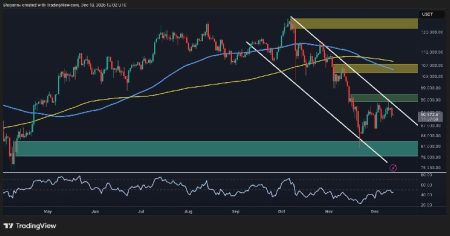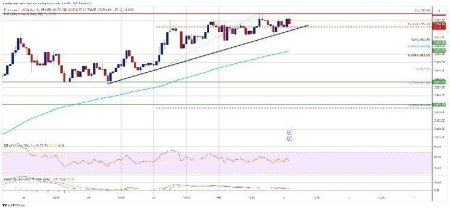Crypto Market Faces Widespread Pullback as Bitcoin Tests Critical Support
Institutional Sentiment Shifts Amid Market Volatility and Geopolitical Tensions
The cryptocurrency market is experiencing a significant downturn, with flagship digital assets retreating from recent highs as institutional investors pull back and market sentiment cools. This correction comes amid heightened geopolitical tensions and macro uncertainties, forcing analysts to reassess the strength of the current bull cycle.
Bitcoin, the leading cryptocurrency by market capitalization, is trading around $110,800, representing a decline of approximately 3.4%. Meanwhile, Ethereum, the second-largest digital asset, has fallen more steeply by about 4.5%, pushing its price below the psychological $4,000 threshold. According to data from CoinGecko, the total cryptocurrency market capitalization has contracted by 4.4% over the last 24 hours, shrinking to $3.85 trillion. Notably elevated trading volumes suggest that market volatility is unlikely to subside in the immediate term.
Technical Support Levels Under Increasing Pressure
The recent liquidation cascade has pushed Bitcoin dangerously close to $112,500, a level that represents the short-term holder realized price—effectively the average cost basis for newer market participants. Maarten Regterschot, an analyst at market intelligence firm CryptoQuant, identifies this as a traditionally strong support zone during bull markets, but raises concerns about its continued resilience.
“This level has now been tested for the fourth time in just a month and a half, which is not indicative of underlying strength in the market,” Regterschot explained. “While it continues to function as support for now, we know that repeated tests of any support level inherently weaken it over time. The data suggests fewer buyers are stepping in to defend this threshold compared to previous tests.”
The market’s fragility appears to be exacerbated by renewed international tensions. Ilia Otychenko, Lead Analyst at cryptocurrency exchange CEX.IO, points to specific geopolitical catalysts behind the recent market behavior. “We were beginning to observe early indications of market recovery until statements from China’s Commerce Ministry reignited concerns about potential trade war escalation,” Otychenko noted. The ministry’s stated commitment to “fight to the end” has redirected market attention back to the unresolved U.S.-China trade dispute, creating what analysts describe as a persistent cloud of uncertainty hanging over both traditional and cryptocurrency markets.
ETF Flows Reverse Course as Institutional Sentiment Deteriorates
The cautious market outlook and recent price deterioration coincide with a marked reversal in capital flows for U.S.-listed spot Bitcoin exchange-traded funds. After setting yearly inflow records earlier this month, these investment vehicles are now experiencing significant outflows, reflecting a rapid shift in institutional sentiment.
“Cryptocurrency ETFs continue to feel the aftershocks of last week’s tariff-driven market selloff,” Otychenko observed. “If current geopolitical tensions persist or escalate further, additional withdrawals from these investment vehicles remain highly probable.” This assessment follows a substantial single-day outflow of $326.5 million from U.S. spot Bitcoin ETFs on October 13, according to data compiled by analytics platform SoSoValue.
This abrupt change in institutional behavior represents a stark contrast to the situation just days earlier. Bitcoin ETF inflows had reached their highest point of the year on October 6, underscoring the rapid deterioration in market sentiment. The shifting mood is further reflected in prediction market data from Myriad, a platform launched by DASTAN (parent company of crypto news outlet Decrypt). The platform’s “greed” sentiment indicator has fallen from 64.1% on Monday to below 50% currently, while the “fear” indicator has climbed to 51.1%, suggesting traders are increasingly adopting cautious, risk-averse positions in response to the uncertain market environment.
Technical Analysis Points to Potential Further Downside
The convergence of these bearish factors has technical analysts mapping out potential downside scenarios should current support levels fail to hold. CryptoQuant’s Regterschot indicates that if the critical $112,500 support level gives way, the next significant support based on the short-term holder realized price metric would be approximately $103,500.
“Historical data from the 2025 bull run shows that Bitcoin typically found support at levels roughly 10% below the average cost basis of short-term holders during corrective phases,” Regterschot elaborated. “Assuming the broader bull market remains intact despite current weakness, this lower level is the next probable price target Bitcoin could move toward in the coming sessions.”
Market Outlook Remains Cautious Amid Multiple Headwinds
As cryptocurrency markets navigate this period of uncertainty, traders and investors appear increasingly cautious. The combination of technical weakness, reversing institutional flows, and external macroeconomic pressures creates a challenging environment even for digital assets that had shown remarkable resilience earlier in the year.
Market participants are closely monitoring not only price action and support levels but also geopolitical developments that could further impact risk sentiment across global financial markets. The current market structure suggests that while long-term bullish fundamentals for cryptocurrencies may remain intact, the near-term path could involve additional volatility and potential retests of lower support levels before confidence returns to the sector.
With Bitcoin testing critical technical thresholds and sentiment indicators swinging toward fear, market observers note that how prices respond to current support levels could significantly influence the direction of cryptocurrency markets through the remainder of the quarter. As institutional investors reassess their cryptocurrency exposure and geopolitical tensions remain unresolved, market participants should prepare for continued uncertainty in what has already been a tumultuous year for digital assets.















